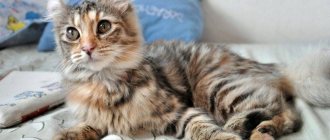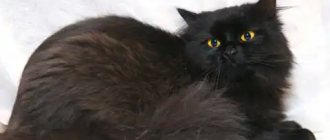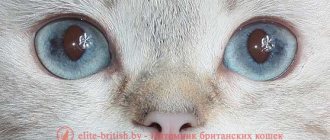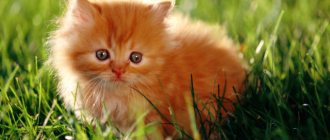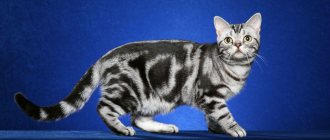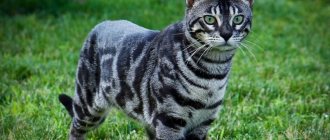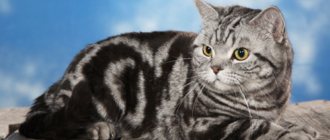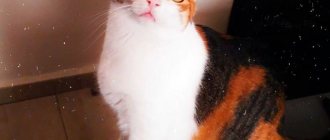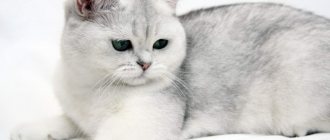Where does the British marbled cat come from?
Since the beginning of the 20th century.
British cats included not only plain blue animals, but also tabby cats with different shades on their fur coats. Thus, in 1901, American felinologists registered a Belle cat with a red tabby color. British marbled cats appeared as a result of crossing with other breeds
The consequence of two world wars was the almost complete extermination of the British breed, so breeders began to crossbreed pets with representatives of other varieties - Burmese, Russian Blues, Persians and Scottish. The result was the appearance of many varieties of British color while simultaneously preserving the breed characteristics (wide paws, protruding cheekbones, “plush” coat).
At the same time, among all the variations of the striped coat of the British fur coat, it is the marble color that is considered classic, occurring naturally. Zoologists are inclined to believe that the symmetrical darkening on the fur of catfish from Foggy Albion is an inheritance from wild Asian or African ancestors.
BRITISH STRIPED COLOR (BRINCH, MACKERL)
The striped color of the British (British brindle tabby) must comply with all the same standards as the spotted one, only the pattern on the back and sides must have clear and uninterrupted stripes. In the color of a British Tabby Shorthair cat, the stripes should start at the spine and extend all the way to the paws. The stripes of a British brindle cat are narrow and frequent (and it is believed that the more often the better). Mackerel stripes (mackerel) should not intersect each other, be strictly vertical and always contrasting.
A brindle (striped) British kitten, even with very clear stripes, can “stretch” its color by adulthood and, if the stripes begin to be interrupted anywhere, the color is reviewed by experts and assigned - spotted. The full color of a British brindle kitten will be formed only by the age of one year (other tabby colors are not subject to such changes and most often do not change the appearance of the tabby pattern in adulthood).
British tabby cats are not as common as spotted cats, but more common than marbled cats.
The eye color of British tabby cats can be copper (golden, orange) or green (gold, occasionally silver).
Chocolate tabby British kitten: photo of California
TORTIE BRITISH: COLOR STANDARD
British tortoiseshell tricolors combine finely spotted colors in equally distributed tones of the red and black color groups or patchwork (in the case of a combination with white).
The color should look harmonious. The tones of the two color groups must be distributed evenly throughout the body; spots of the red group are allowed.
The fur of British tortoises is soft, dense, plush, exceptionally short and slightly protruding (not lying close to the body).
The eyes of a British tortoiseshell cat can be either copper or dark gold.
The nose and paw pads can be:
- black;
- pink;
- black and pink.
See the tortoiseshell color of the British cat in the photo in this article.
Types of drawings
Tabby is not one specific pattern, as many people believe. There are several varieties of it, and all are considered standard. The pattern appears due to the A gene (agutti). A British female with the color formula “AA” gives birth to only patterned kittens, and with “Aa” the ratio of patterned kittens to plain ones is 50%. Cats with the formula “aa” will be monochromatic.
There are four main types of tabby patterns: ticked, striped, marbled, spotted.
Ticked (Abyssinian)
At first glance, it may seem that the British ticked coat is a solid color, but this is not the case. The color of their coat is not at all uniform: the whole body has barely noticeable stripes, spots or specks (there are “freckles”), slightly darker than the main tone of the British. The tip of the tail is usually dark. Eyes are golden or green.
Striped, brindle (mackerel)
The British tabby cat is the most popular cat available. The second name appeared due to the similarity with the color of the mackerel fish. The pattern is characterized by frequent narrow, clear stripes throughout the body, especially along the ridge. British tabbys are characterized by necklace-like lines on the chest and a broken stripe on the forehead, reminiscent of the Russian letter “M”. The British cat's full brindle coloration develops by the age of one year.
Classic (marble)
One of the most favorite colors among breeders of this breed is the marbled tabby. It is visible already from the birth of the kitten, it may merge slightly, but by two months it has a clear pattern. The body is covered with wide ornate patterns with clear outlines on the back, sides and vague ones on the abdomen and paws. The color of the pattern contrasts with the main shade of the Briton’s body – a kind of marble on silver.
Spotted (leopard)
A cat of the British breed with this coloring is similar to a representative of the wild - a leopard, but in miniature. Wide stripes are intermittent and represent spots of various sizes. Eye color: copper, green.
White mark
What kind of eyes do British cats with white markings, the so-called bicolors, harlequins and vans have? In this case, everything depends on the main color - the color of the cat’s eyes should correspond to it. Most often, British cats with white spots are yellow-eyed or green-eyed, but sometimes there are rare heterochromic specimens among them.
However, all these nuances are important only for those who actively participate in exhibitions or are involved in breeding cats. For most ordinary cat owners who have British cats, the color of their pets' eyes does not matter. Yellow, green, blue or even different ones - they are still the most favorite!
Where did this color come from and why is it called that?
The question of where cats of such bizarre colors and different breeds come from will certainly arise if a British kitten appears in the house. The tabby color was most likely inherited by domestic cats from their wild ancestors, the Nubian Dun. It is from this species of cat that all our short-haired pets originated.
As for the term “tabby” itself, there are several versions about its origin. The most beautiful sounds like this. Somewhere at the beginning of the 17th century, silk fabrics, which were worth their weight in gold, were first brought to England. Their pattern was very similar to a cat's color and was called "tabbis". And when they later began to breed cats with a similar color, they were called tabby. In addition, cats of this color, like silk, were very expensive, since breeding them is extremely difficult - it is difficult to obtain the necessary pattern, shade and eye color that matches them.
Health
The British Shorthair cat is not susceptible to hereditary diseases. She is in excellent health. However, this does not mean that vaccination and preventive examinations by a veterinarian can be neglected.
It must be taken into account that sexual and physical maturation in general occurs late in the British - around the age of four. It is at this age that kittens turn into adult cats: they show all the solidity and massiveness provided for by the standards. There is no point in sounding the alarm or suspecting dystrophy until this moment.
In comfortable conditions, a Briton lives on average 15 years. However, there are record holders in the breed whose age has exceeded 20. The reasons are simple: lack of stress, active cat life, balanced food and, of course, unconditional love. The well-being of the British largely depends on feeling like a member of the family.
Marbled Tabby
The marble tabby color in cats is the most beautiful, bright and complex. In addition, it is also the rarest due to difficulties in crossing - two marbled individuals can produce a tabby or spotted kitten. Such British cats wear three parallel stripes on the back, and large closed circles on the sides, inside of which there are brightly colored spots. Such a pattern should not intersect or be interrupted. In addition, a Marbled Briton must have the following markings:
- A pattern on the back of the head and shoulders resembling a butterfly.
- Patterns on the cheeks that start from the very corners of the eyes.
- "M" pattern on the forehead.
- The neck and chest are decorated with necklaces - the more, the better.
- There are spots on the tummy.
- The paws and tail must be ringed.
- The circles on the hips must be closed.
The color is rejected if the pattern is not contrasting enough, or if it shows residual faded stripes.
In a British cat, the merle color can be identified from birth. However, final alignment and clear drawing occur by two months. Therefore, if you want to get a real British harlequin, wait until this time, and do not adopt a kitten earlier.
Standard lilac color
Felinologists, people involved in breeding cats, opt for light and ordinary warm varieties. Based on the standards, these shades are represented as cool gray with a slight pink tint.
kitten BLH c
lilac cat british
British cats have their own designation for lilac color - Lilac BRI c.
The hairline should be colored in a uniform tone, even without small spots of a different shade. Only the lower part of the fur is slightly lighter so that it is almost not noticeable. The wool is not rough, very pleasant to the touch.
The nose and paw pads are also colored lilac-pink.
The eye color is usually rich amber or even a contrasting copper color.
Kittens in childhood, up to 4-5 months, may have inclusions, but as a result of the maturation of the solids, everything becomes shaded and the coat becomes monochromatic.
british longhair cat
British shorthair lilac color
The British lilac cat can be in the following colors:
- Light lilac (slightly with a pink tint);
- Lilac with a slight violet tint;
- Dark purple a little coffee color.
Required elements
The tabby color, despite many variations, has a number of unchanged elements:
- Ticking is actually the presence of the pattern itself. In this case, the hairs of the coat should be uniform in color down to the base.
- On the forehead of such cats there is always a pattern resembling the letter “M”, the so-called scarab sign.
- There should be a fingerprint-shaped spot on the back of the ear.
- The nose and eyes should be outlined. In this case, the color of the outline should be the same as the main color.
- The pattern, if there is one, must include the following elements: “necklace” - three closed stripes on the chest; “curls” on the cheeks; There are two rows of double spots on the tummy. All drawings should be clear and rich, and the coloring should be deep.
- There are also typical eye colors for tabbies - golden, orange and copper. If the color is silver, then the cat's eyes should be green.
If a Briton's color is blurred, and the patterns are cloudy and merge with the main color, then this is a defect. Most likely, one parent was a tabby and the other was a solid.
Yellow eyes of warm fire
What kind of eyes do British cats have of solid colors or, in other words, solid colors? All monochromatic British cats, except white ones, are left with no choice in the standard - their eyes are yellow, sometimes even closer to orange. The brighter and more saturated the shade, the more beautiful and expensive the cat.
British tortoiseshell cats also have yellow eyes. It is genetically determined that mainly female cats are born with such “pieds”. If a tortoiseshell cat is born, then this is the result of a genetic mutation, and the boy, alas, is infertile.
The classic yellow eye color is also found in spotted-striped animals - this color is also called tabby (tabby) or drawn. If there is no gold or silver in the color of the British minke whale, then, in theory, it should also be yellow-eyed.
Types of colors
Selection work on representatives of the British breed, involving various bloods, has led to a variety of both colors and breed types. If initially the British had short hair with a thick undercoat, then crossing with the Persian cat made it possible to obtain semi-long-haired animals. The colors of British longhair cats correspond to the colors of shorthair cats.
Many people only think of Britons as smoky, blue or tabby cats and don't even realize how many colors the breed has. Even a pair of quite ordinary parents can produce a kitten of a rare color.
To organize the variety of colors of British cats, they are divided into types and groups according to color, pattern and method of pigmentation.
Types of colors of British cats:
- solid (or plain);
- typed: smoky, veiled, shaded;
- gold;
- silver;
- tortoiseshells;
- color point;
- particolors: harlequin, bicolor, van, mitted;
- tabbies: spotted, striped, marbled, ticked.
A table of the colors of British cats will help you imagine all the diversity.
TYPES OF BRITISH TORTIETY COLORS
There are more than 80 variations of bright colors in tortoiseshell cats, and each cat is unique. And there is not a single turtle in the world that would replicate every spot and every hair of its fur identically.
Let's divide all types of colors into subgroups.
CLASSIC TURTLES
| Blue cream (BRI g) | Black-red (BRI f) | Chocolate red (BRI h) |
| Lilac-cream (BRI j) | Fawn cream (BRI r) | Cinnamon red (BRI q) |
SMOKY TURTLES
Smoke tortoiseshells are a color that combines the classic tortoiseshell with smoke (silver colored at the roots). Such turtles are rare and outwardly almost do not differ from classic ones, since the undercoat, which is visible only if you part the fur, can be immediately overlooked. Looking at such a cat, one gets the impression that the color is not entirely bright, but rather slightly blurred. This feature appears due to smoke in the undercoat. The color looks smoother, areas of differently colored parts are smoothed out.
Smoky colors are:
- black-red smoky BRI fs;
- chocolate red smoky BRI hs;
- blue-cream smoky BRI gs;
- lilac-cream smoky BRI js;
- cinnamon-red smoky BRI qs;
- faun cream smoky BRI rs.
3. TORBIE (TORTOISE TABBY)
This type of color - torby - is represented by a combination of the classic tortoiseshell color and tabby color (pattern).
TORBY is BLACK (or other lightened tone) + RED (or cream) + TABBY (pattern).
Types of colors:
- black and red tabby (spot, stripe, marble) f 24, f 23, f 22;
- chocolate-red tabby (spot, stripe, marble) h 24, h 23, h 22;
- blue-cream tabby (spot, stripe, marble) g 24, g 23, g 22;
- lilac-cream tabby (spot, stripe, marble) j 24, j 23, j 22;
- cinnamon-red tabby (spot, stripe, marble) q 24, q 23, q 22;
- fawn-cream tabby (spot, stripe, marble) r 24, r 23, r 22.
CAKE (TORTOISE COLOR POINT)
Tortie is the name of a color that combines tortoiseshell and color point (otherwise known as Siamese).
This rare combination of colors is obtained as a result of mixing different groups of colors and adding the color point gene (it must be present in both parents).
CAKE is BLACK (or other lightened tone) + RED (or cream) + POINT (Siamese).
Colors can be:
- torty point (black tortoiseshell) f 33;
- blue cream point (blue tortoiseshell) g 33;
- chocolate-tortie-point (chocolate tortoiseshell) h 33;
- lilac-torty-point (lilac tortoiseshell) j 33;
- cinnamon-tortie-point (tortoiseshell cinnamon) q 33;
- fawn-torty-point (tortoiseshell fawn) r 33.
CALICO (BICOLOR TURTLES)
The calico color is also called the “patchwork tortoiseshell.” This is one of the most beautiful and elegant colors - tortoiseshell combined with white (you can also hear the name tricolor). It is put together like a mosaic from “scraps” of different colors. These turtles are three-colored, and different colors do not mix or shade, but have clear contours.
CALICO is BLACK (or other lightened tone) + RED (or cream) + WHITE.
Tortoiseshell Tricolor Britons can be:
- black tortoiseshell with white (f 03/02/01);
- blue tortoiseshell with white (g 03/02/01);
- chocolate tortoiseshell with white (h 03/02/01);
- lilac tortoiseshell with white (j 03/02/01);
- tortoiseshell cinnamon with white (q 02/03/01);
- tortoiseshell faun with white (r 03/02/01).
where 03 is bicolor, 02 is harlequin, 01 is van.
MIXED COLOR: TORTIE TABBY WITH WHITE
Tortoiseshell cats can also have a tabby pattern, combining 3 colors at the same time. Tortoiseshell tabbies with white colors are obtained by mixing several types of colors; they are rare.
TORTIE TABBY WITH WHITE is BLACK (or other lightened tone) + RED (or cream) + TABBY + WHITE.
There are a lot of color options. And, like all turtles, the color is always elegant, bright and unique.
Possible tabby colors
Among tabby cats, gray and silver cats predominate with markings of a wide variety of colors: lilac, chocolate, blue, smoky black, reddish. But this does not mean that other tabby colors are rare. In the table below we look at the main variations of tabby color.
Table 2. Possible flower combinations for tabby color
| Color name | Marking color | Leading coat shade |
| Amber | Smoke black | Peach |
| Black silver | Deep black | Silver |
| Blue | Gray dust | Ivory |
| Blue silver | Grey | White |
| Bronze | Dark chocolate | Warm cream |
| Brown | Black night | Gray with brown or copper fade |
| Cameo | Fiery red | Warm ivory |
| Caramel | Milk chocolate with light color | Beige |
| Coal | Black chocolate | Smoke gray |
| Chestnut | Bright brown | Cream with possible orange undertone |
| Chocolate silver | Milk chocolate | Light blue silver |
| Cinnamon | Light chocolate with red flecks | Several shades lighter than the drawing |
| Golden cinnamon | Cinnamon | Ivory |
| Cream | Bright cream | Pale cream |
| Cream silver | Cream | Delicate silver |
| Faun | Light beige with cinnamon | Pale beige |
| Gold | Black | Milk chocolate with light color |
| Delicate amber | Grey, light gray | Tender peach |
| Lilac | Gray with splashes of pink or blue | Light cream |
| Peach | Brown with pink | Delicate cream |
| Red | Fire orange | Several tones softer than the original pattern |
| Purple silver | Lilac | Light silver with lilac splashes |
| Silver | Deep black | White |
It is worth noting that colors may vary depending on the design. Thus, spotted patterns are often presented in warm colors: golden, chocolate, wheat, brown, reddish, red. The classic type combines contrasting patterns of dark stripes on a light background: cream, yellowish, gray. The basis for dark striped patterns is silver and gray. The ticked type offers almost all possible colors. You can read about the mechanisms of genetic inheritance of pigments from cat to cat below.
Pigments and options for their transmission
In addition, the pattern may vary depending on the breed.
Table 3. Tabby color options for different breeds
| Breed | Color name | Marking color | Primary coat color |
| California speckled | Bronze, coal, snow leopard, royal glitter | Bronze - chocolate, charcoal - dark chocolate, snow leopard - black, glitter - brown with black | Bronze, snow leopard - ivory, coal - dark gray, glitter - gold |
| Egyptian Mau | Mottled Bronze, Smoke Spots, Mottled Tin | Bronze – chocolate, haze – dark chocolate, tin – gray-black | Bronze - cream, haze - dark gray, tin - silver |
| Ocicat | Golden cinnamon, sienna, spotted tawny | Cinnamon – chocolate, sienna – beige, tawny – dark chocolate | Cinnamon, sienna - ivory, tawny - red |
| Australian smoke | Golden haze, peach | Haze - golden chestnut, peach - brown with a hint of pink | Haze is several shades lighter, peach is a light cream |
| Bengal cat | Leopard, snow | Leopard - red markings in black circles, snow - cream markings in black circles | Leopard – yellow cream, snow – white |
Tabby cats with a rarer color are valued higher - because of this, they can cost more than their counterparts.
Where do motley cats come from?
As you know, melanin, a pigment, is responsible for the color of an animal’s fur, skin and eyes, depending on the amount and type of which the fur acquires one color or another. There are only two varieties of this pigment:
- eumelanin, which gives fur, skin and eyes black color and its shades (including lilac and blue);
- pheomelanin, responsible for red and cream coat colors.
The gene responsible for the appearance of red or black color is carried on the X chromosome. Two X chromosomes in mammals are characteristic of the female sex, and a set of XY chromosomes is characteristic of the male sex. Accordingly, a tricolor cat with two X chromosomes is very rare and a kind of genetic anomaly - according to statistics, there is only one cat per thousand cats. However, this does not make it more valuable: such cats are usually sterile.
A somewhat unique and very famous calico cat, Jake is one in a thousand calico cats.
On the other hand, calico cats are quite common. At the same time, such a coat color is not a sign of any specific breed; among some breeds, such a color is more common and is considered a sign of the standard, among others it is less common or does not occur at all.
The variegated cat color is also called tortoiseshell, while a tortoiseshell cat can be two-colored, but in this case there is no white in its color. Therefore, tri-colored “turtles” are sometimes called “Tortoiseshell and white.”
The Calico color is sometimes considered a variety of tortoiseshell, although such cats look differently: predominantly white with large, distinct spots of two other colors - usually black and red.
The name for the calico color was given by the Indian city of Calicut (modern name - Kozhikode) and a special type of cotton calico fabric invented there.
In tortoiseshell cats, the colors are mixed and do not form separate spots. White may form large areas, but the other two colors are interspersed and do not create large single-color markings.
The colors found among calico cats are not necessarily black and tan. White is an obligatory component, a kind of background, but the spots can be blue with cream, chocolate with red, purple with cream, etc.
The main thing is love and affection
Cats of this breed are very sensitive and vulnerable. They definitely need to be petted, otherwise they get offended and worried. Simply feeding is clearly not enough. You need to take her in your arms and say kind words. They feel everything. Sometimes, even too much.
However, these cats will never impose themselves and get in the way
The owner himself must take the initiative and show attention to the pet.
Tabbies are very friendly and trusting. This breed is an excellent choice for families with small children. Cats will patiently endure any treatment from their little owners and will never show even a shadow of aggression towards them, not to mention extending their claws.
Representatives of this breed get along well with other pets. They can make excellent friends even with a pet rat, hamster or parrot, if there are any in the house.
Blondes rule!
White color is not the most common among representatives of this breed: it is very difficult to breed such kittens, and white cats of any breed often suffer from deafness, so selection work with white British cats has not been carried out for some time. But if such a kitten appeared in the litter by the will of nature, the color of its eyes can be a real surprise for the owner.
British blondes can have yellow eyes, more precisely, gold, copper or amber - this is the most common option. It is extremely rare, but there are white British cats with blue eyes - they do not participate in breeding, but this does not detract from their unique beauty.
And finally, perhaps the most incredible white British cats are those with different eyes, a phenomenon called heterochromia. Usually one eye is blue and the other yellow. In English, such cats are called "Odd-Eyed", that is, strange-eyed.
Tabby (tabby) color of a British cat
The group of tabby (tabby) colors unites all cats that have a pattern in their color.
Presumably, the name “tabby” itself comes from the type of design (“tabbis”) on precious silk fabrics brought to England in the 17th century from the countries of East India.
Genetically, all cats (and male cats) are carriers of some kind of pattern - all are “tabbiks”, however, in the genetic makeup of cats there is a so-called “agouti” factor, which either allows the pattern to open - then it becomes visible, or does not allow it, then we see the animal has a solid color. A visual confirmation of this is the shadow pattern in small kittens of a solid color. Kittens “moiret”, stripes and spots are visible, which disappear with age. But, if the “agouti” factor allows the drawing to open up, the result is a “tabbik” - a patterned cat.
IS THERE A TORTIE BRITISH CAT?
Here the matter is in the usual genetics of the colors of the British.
There is no tortoiseshell color in British cats - only in cats. If this could happen, then the cat would be sterile, i.e. could not have offspring.
The fact is that cats have two X chromosomes, each of which can carry either black color (or its derivative) or red (or cream). The combination of X chromosomes from two different color groups in a cat gives the tortoiseshell color. But cats have only one X chromosome, so they can only be black or only red.
Features of character and behavior
The British cat, massive and clumsy, is actually very, very active. It’s just that he prefers sleep to any active activity. The British sleep 20 hours a day, sometimes without stopping to eat.
Up to 3-4 years The British are not yet fully formed, both physically and psychologically. At this age, they are, in essence, still kittens with appropriate behavior - active and mischievous. Then the kitten becomes much calmer.
The breed is characterized by absolute self-sufficiency. The British Shorthair cat itself determines the rhythm of life, the time for affection and, especially, for games. Shows independence from early childhood. Even a small kitten has sacred knowledge of its rights. The most important thing is not to waste time. Kittens up to one year old are amenable to suggestion and education. After - no.
Soft and independent Britons have their own opinion about everyone. The kitten will choose a place to sleep himself. The owner’s task is to equip it. When dealing with a Briton, you must remember: he has remarkable intelligence and memory. Reviews indicate that from childhood the kitten demands respect for its person and really does not like noise.
You will have to forget about closed doors in the apartment: this will cause shock in an absolutely calm cat, even to the point of depression. Ideally, of course, the British should be able to roam freely. Then neither the cat nor the owner will experience any shocks.
The British Shorthair cat is non-aggressive, but will not allow itself to be offended. She is unobtrusive and rarely talks out loud about her feelings. If a Briton wants to eat, this will be expressed in a silent picket next to the cup.
Kittens get used to the family and are sincerely attached to the owner, but they can do quite well without his company.
Who is suitable for a British tabby?
If you consider the main qualities of a pet to be affection and the ability to cuddle it, then this breed is not for you.
British cats have an independent character and live “on their own.” They are not attached to any family member. They are not afraid of loneliness, and therefore are suitable for business people who stay at work for a long time.
The British do not require additional education. They are clean, and therefore the cat's litter box will have to be changed more often than usual: these clean people can ignore the dirty toilet and relieve themselves in another place. But in general they rarely bully.
Their coat does not require special care. Animals take care of their hygiene independently.
The British tabby dog will be a great friend for a child. However, he will not accept excessive affection from him: British cats do not like excessive attention to their person, and will not sit on your hands. Rarely shows aggression, and therefore can get along even with dogs. British kittens are very playful up to a year old, but with age they become lovers of lounging on the sofa.
Their motto in life becomes the phrase: “Once you’ve eaten, you can sleep.” If you sleep, you can eat.”
With such a lifestyle, it is important for the breeder to ensure that the pet does not gain excess weight.
Conclusion
A large selection of cat color palettes will suit everyone's tastes. Britons do not require much care and will make an excellent friend and pet.
https://youtube.com/watch?v=Eifs1WQ8EKQ%3F

